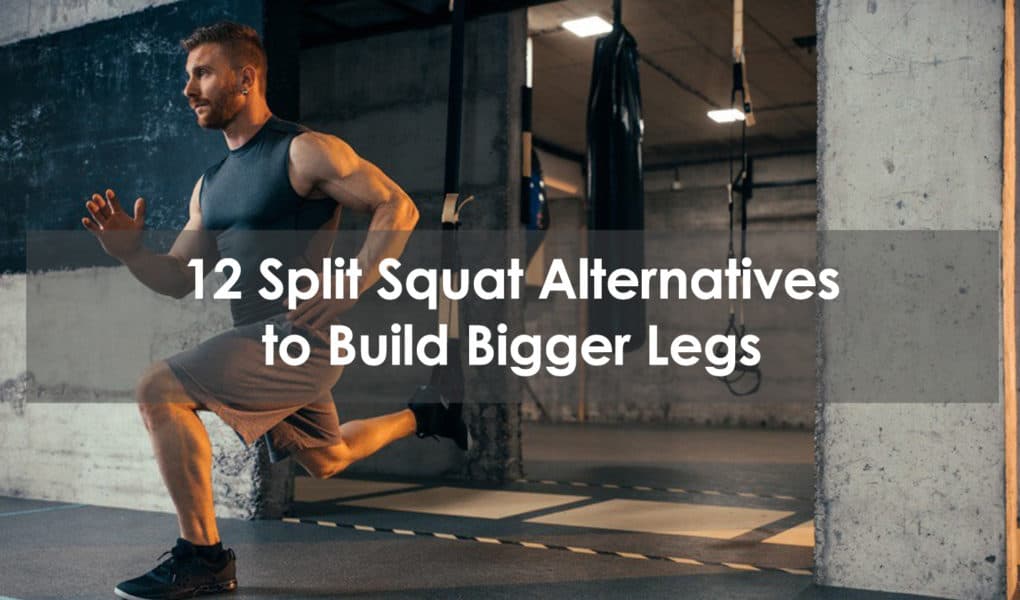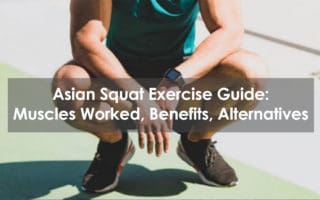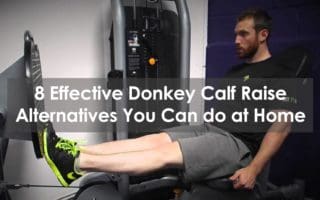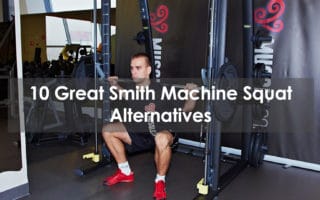The split squat is a great quadriceps and glute developer that allows you to work each limb unilaterally. This is an exercise that should form part of your routine.
However, there are many other lower body exercises, many that also allows you to work each leg by itself, that are excellent alternative exercises to the split squat.
Here are a dozen of the best of them to help you get to your fitness goal.
1. Bulgarian Split Squats
Why It’s a Great Alternative
The Bulgarian Split Squat is an excellent unilateral exercise that can be done with no equipment apart from a bench. This squat variation places direct stress upon the muscle fibers of your quads and glutes, while also hitting the gastrocnemius muscles of your calves.
Muscles Worked
Glutes, quadriceps, calves, spinal erectors
Equipment Needed
Bench or box
Performance Tips: Do not lean forward and keep your foot in contact with the floor. You can do the exercises with a kettlebell, dumbbells, or with no added resistance beyond your own body weight. Be sure to move through a full range of motion.
How To Do It
- Facing away from a box or bench, place your rear foot on the bench or box and the other foot forward until it s directly under your hips.
- Stat by flexing the leg that is out in front of you, while at the same time pushing the elevated knee toward the floor. Keep your chest and shoulders upright while you are holding the rings of a kettlebell at chest height.
- Once the front leg is parallel to the floor, return to the starting position by pushing the foot into the floor until lockout.
2. Single Leg Romanian Deadlift
Why It’s a Great Alternative
The single-leg Romanian deadlift improves balance and stabilization.
Muscles Worked
Glutes and hamstrings
Equipment Needed
Single dumbbell
Performance Tips
Control the weight going down; do not round your back.
How to Do It
- Stand erect in a shoulder-width stance with the weight in your right hand.
- Start the movement by taking the right leg backward, keeping your chest up as you flex at the hips while lowering the weight to mid-shin with your right hand. Your left leg should be slightly bent, while your left arm is used to help with balance.
- Reverse the action to return to the start position.
3. Reverse Lunge
Why It’s a Great Alternative
The reverse lunge is an excellent exercise to stabilize and strengthen the knee joint. It also places more direct emphasis on the muscle fiber of the hamstrings than most other alternatives exercises to the split squat. This is one of those athletic movements that will make you more agile.
Muscles Worked
Quadriceps, glutes, adductors, hamstrings, and calves
Equipment Needed
None
Performance Tips
Keep the torso upright, toes pointed straight and the body stabilized before descending.
How To Do It
- Stand with feet shoulder width standing upright with your hands on your hips.
- Move your left leg back behind your body, simultaneously bending your right knee and lowering your hips. Keep your torso upright.
- Go down to the point that your left knee is at 90 degrees and the right thigh is parallel to the floor.
- Return to the starting position by pushing with the right leg, squeezing your glutes to stand up while simultaneously bringing the left leg back u under you.
4. Pistol Squat
Why It’s a Great Alternative
The pistol squat is a great body strength exercise that works each leg unilaterally. As well as building strength in the quads, it will improve flexibility, balance, and functional mobility.
Muscles Worked
Glues and quadriceps
Equipment Needed
None
Performance Tips
Keep the planted foot stable and control your movement. This is a difficult exercise that you will probably need to perfect progressively. Begin by holding onto support for balance and eventually advancing to the full depth unassisted pistol squat.
How To Do It
- Stand upright with your feet shoulder width apart.
- Raise one leg in front of your body as you push your hips backward and flex the standing leg into a squat. Yu can allow tour arms to go out to the sides or in front of you to help with your balance.
- Lower the hips as far as possible while keeping the front leg lifted.
- Push back up to the starting position.
5. Goblet Squat
Why It’s a Great Alternative
The goblet squat is an effective exercise to strengthen the core and increase mobility while also building the quads and glutes. It will also enhance core strength. In addition, there is quite a bit of hamstring activity with this exercise. If you are not a fan of barbell squatting, this is a good alternative for you. It is also beneficial for people who have hip issues.
Muscles Worked
Quadriceps, glutes, hamstrings, tensor fasciae latae
Equipment Needed
Kettlebell
Performance Tips
Do not let the knees cave inward; keep your chest up and back flat throughout the movement. Continue in a fluid motion, not locking your knees out between reps. This will enhance your time under tension.
How To Do It
- Stand tall, feet shoulder-width apart and grab the ring of a kettlebell, holding it at chest level.
- Begin the movement by flexing at the hips and knees at the same time, keeping your feet flat and your chest and shoulders upright.
- Continue downward until the top part of your hips are below the top part of your knees. Your legs should form a 90-degree knee angle.
- Return to the starting position by pushing your feet into the floor and your knees out, keeping the kettlebell close to the body.
6. Lunge
Why It’s a Great Alternative
The lunge allows you to improve your hip flexibility, balance, and stabilization. These factors make it excellent assistance exercise to squats and deadlifts. This exercise also enhances core stability.
Muscles Worked
Quadriceps femoris, gluteus maximus, gluteus medius, abdominals
Equipment Needed
Loaded barbell
Performance Tips
Control the weight as you step away from the center of the body.
How To Do It
- Stand with your feet shoulder-width apart. Place a loaded bar across your shoulders.
- Step forward with one leg out in front of the body. Bend the back leg so the knee nearly touches the floor. Keep your chest vertical and your head up.
- Push off the front foot, bringing it back under the body to return to the starting position.
7. Leg Extension
Why It’s a Great Alternative
The leg extension is the best exercise you can do to target the quadriceps muscles, bar none. You can target your quads with heavier loads on this exercise without any compressive loads on your back. As a result, it is a great exercise for leg hypertrophy.
Muscles Worked
Quadriceps
Equipment Needed
Lex extension machine
Performance Tips
Pause at the top and bottom of the exercise, stopping 10 percent short of a lockout in both directions. This will avoid potential knee pain and increase your time under tension. Maintain a slow, controlled action throughout.
How To Do It
- Sit on the leg extension machine and grasp the handles.
- Bed your knees and place your ankles under the pads.
- Lift your legs until they are parallel to the floor. Slowly lower the weight until it is 10 percent short of full contraction and then lift it again.
8. Seated Leg Curl
Why It’s a Great Alternative
The seated leg curl is the best exercise you can do for hamstring activation.
Muscles Worked
Hamstrings
Equipment Needed
Seated Leg Curl machine
Performance Tips
Pause at the top and bottom of the movement. Control the weight throughout your repetitions.
How To Do It
- Sit on the leg curl machine and place your legs in position with your ankles on top of the ankle pads and your legs extended at hip height.
- Push down on your ankles to lower the weight to full extension.
- Return and repeat.
9. Step Up
Why It’s a Great Alternative
The step does not require any equipment. It is a functional exercise that is universally accessible and does a good job of strengthening the quads and glutes. Weight can be added by holding dumbbells in your hands.
Muscles Worked
Quadriceps, gluteus maximus, gastrocnemius
Equipment Needed
10 or 24-inch box
Performance Tips
Place your feet in the middle of the box. Keeping your torso upright, control the weight up and down.
How To Do It
- Stand in front of a box with feet shoulder width apart.
- Step up onto the box with your right foot nd then your left.
- Step down with your right foot nd then your left foot to return to the starting position.
- Place your feet in the middle of the box. Keeping your torso upright, control the weight up and down.
10. Jefferson Squat
Why It’s a Great Alternative
The Jefferson squat is a fantastic exercise for developing strength through the bottom part of the squat. This squat variation avoids placing compressive loads on your spine.
Muscles Worked
Hamstrings, quadriceps, gluteus maximus, abdominals
Equipment Needed
Olympic bar
Performance Tips
Do not arch your back. Keep your core tight. This is a demanding exercise so don’t go too heavy.
How To Do It
- Place the bar on the floor and straddle the middle of it.
- Squat down and grasp the bar by placing one hand in front of your body and the other one behind you.
- Squat the weight up until the arms and legs are locked. Keep your chest up, your back and head straight and your feet flat. Bend your knees as you lower the bar to return to the starting position.
11. Narrow Stance Squat
Why It’s a Great Alternative
The Narrow or Close Stance Squat is a fantastic exercise for developing power in the quadriceps. You can use heavier loads on this move than the split squat stance.
Muscles Worked
Quadriceps
Equipment Needed
Squat Rack, Olympic barbell
Performance Tips
Control the weight throughout the movement, and do not lean forward or round the back. Keep your weight on the balls of your feet.
How To Do It
- Stand in front of a squat rack with a loaded Olympic bar on it.
- Place the bar high on your trapezius and space your foot placement shoulder-width apart, the toes pointed slightly outward.
- Bend the knees to descend into the squat until the tops of the thighs are below parallel. Straighten the legs to return to the starting position.
12. Resistance Band Squat
Why It’s a Great Alternative
Resistance band squats make for a low-cost alternative to Olympic bar squats and split squats with dumbbells that you can perform in your home. They are also safer to use than free weights.
Muscles Worked
Quadriceps, glutes, hamstrings
Equipment Needed
Resistance band
Performance Tips
Ensure that the band runs under your mid feet; keep your back neutral throughout the exercise.
How To Do It
- Stand with feet slightly shoulder width apart, toes pointed out and a resistance banded looped under both feet. Hold the other end of the band in both hands with arms in front of you.
- Now drop down into a parallel squat position.
- Push through the heels to return to the start position.
Conclusion
The dozen alternative exercise options to the split squat give you plenty of variety in planning out your lower body training program. You can effectively make use of these exercise alternative options by choosing 2 or 3 of them for each workout.
Perform a total of around 16 sets for your quads, glutes, and hamstrings, with reps ranging from light weights for 30 reps down to 6 reps with heavy loads. Do this consistently every 5 days, and you will be well on your way to achieving your fitness goal.
Frequently Asked Questions
Should you do split squats (and other unilateral exercises)?
Yes, you should do split squats and other unilateral exercises? Research shows that training each limb by itself leads to greater increases in strength and muscle mass.
Can split squats replace squats?
No, you should not replace standard squats with split stance squats. The basic barbell squat should be used to build strength, power, and muscle mass, with unilateral exercises such as the split squat being used as supplementary exercises. You can of course, also use heavy weights with regular squats.
Is leg press better than squats?
No, the leg press is not better than the barbell squat. With the standard barbell squat, you are moving your entire body through space, whereas the leg press places you in a stationary position. As a result, the leg requires less effort. It also has a biomechanically less efficient movement pattern. The leg press also encourages users to overload the weight and reduce the range of motion even further. So, if you have to choose between the two, go with barbell back squats every time.







